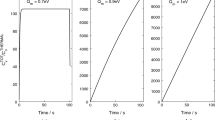Abstract
A conceptual analysis of approaches to describing concentration heterogeneities and structural and phase transformations in submicroscopic and nanocrystalline aggregates formed by cold severe plastic deformation (SPD) is given. The decisive role of the vacancy diffusion mechanism in forming chemical heterogeneities in activated alloys is demonstrated. The concept of the nonequilibrium hole gas and the disclination-dislocation deformation mechanism is used to develop a model approach to describing the behavior of metal systems produced by SPD. Model calculations are compared with experimental data and the main trends for further refining of the model of activated alloy formation are formulated.
Similar content being viewed by others
References
V. M. Farber, “Contribution of diffusion processes to structure formation under severe cold plastic deformation of metals,” Metalloved. Term. Obrab. Met., No. 8, 3–9 (2002).
M. A. Shtremel’, “On participation of diffusion in mechanical alloying processes,” Metalloved. Term. Obrab. Met., No. 8, 10–12 (2002).
Yu. A. Skakov, “High-energy cold plastic deformation, diffusion, and mechanochemical synthesis,” Metalloved. Term. Obrab. Met., No. 4, 3–12 (2004).
M. A. Shtremel’, “Where is diffusion directed to?” Metalloved. Term. Obrab. Met., No. 4, 12–13 (2004).
Yu. A. Skakov, “Formation and stability of metastable phases in mechanochemical synthesis,” Metalloved. Term. Obrab. Met., No. 7, 45–54 (2005).
A. Ye. Yermakov, V. L. Gapontzev, V. V. Kondratyev, et al., “Phase instability of nanocrystalline driven alloys,” Mater. Sci. Forum, 343–346, Part 2, 577–584 (2000).
C. E. Rodriquez Torres, F. N. Sanches, and L. A. Mendoza Zeilis, “Decomposition of Fe2B by mechanical grinding,” Phys. Rev. B, 51(18), 12142–12148 (1995).
Yu. S. Necganev, S. A. Vladimitrov, N. A. Ol’shevskii, et al., “The effect of high-speed deformation on diffusion mass transfer in metals,” Fiz. Met. Metalloved., 60(3), 542–549 (1985).
O. A. Dorofeev, E. P. Yelsukov, A. L. Ulyanov, and G. N. Konygin, “Termodynamic Simulation of Mechanically Alloyed Solid Solution Formation in Fe-Sn System,” Mater. Sci. Forum, 343–346, 585–590 (2000).
V. L. Gapontsev, Diffusion and Structurally Heterogeneous States in Alloys with Localized Vacancy Sources and Runoffs, Author’s Abstract of Doctorate’s Thesis [in Russian], Ekaterinburg (2005).
S. S. Zaichenko and A. M. Glezer, “Disclination mechanism of plastic deformation of nanocrystalline materials,” Fiz. Tverd. Tela, 39(11), 2023–2028 (1997).
V. L. Gapontsev and V. V. Kondrat’ev, Diffusion phase transformations in nanocrystalline alloys under severe plastic deformation, Dokl. Ross. Akad. Nauk, 385(5), 608–611 (2002).
I. M. Livshits, “On the theory of diffusion-viscous flows of polycrystalline bodies,” Zh. Eksp. Teor. Fiz., 44(4), 1349–1367 (1963).
V. I. Vladimirov and F. E. Romanov, Disclinations in Crystals [in Russian], Nauka, Leningrad (1986).
V. V. Rybin, Severe Plastic Deformation and Failure of Metals [in Russian], Metallurgiya, Moscow (1986).
A. V. Nazarov and K. L. Gurov, “Kinetic theory of mutual diffusion in a binary system. The effect of concentration dependence of self-diffusion coefficients on mutual diffusion process,” Fiz. Met. Metalloved., 38(3), 486–492 (1974).
B. I. Smirnov, “Generation of vacancies and variations in density of alkali-galloid crystals under plastic deformation,” Fiz. Tverd. Tela, 33(9), 2513–2526 (1991).
J. S. Vertrano, E. P. Simonen, and S. M. Bruemmer, “Evidence for vacancies at sliding grain boundaries during superplastic deformation,” Acta Mater., 47(15), 4125–4129 (1999).
V. L. Gapontsev, “Mechanical alloying of metals with a big difference of atomic radii,” Electr. J. “Issledovano v Rossii”, No. 177, 1826–1836 (2005).
G. A. Dorofeyev, G. N. Konygin, E. P. Elsukov, et al., “Mössbauer studies of solid-phase reaction kinetics in Fe68Sn32 system on nuclei 57Fe and 119Sn under mechanical alloying,” Izv. Akad. Nauk, Phys. Ser., 63(7), 141–146 (1999).
A. V. Dobromyslov, R. V. Churbaev, V. A. El’kin, and T. L. Trenogina, “Mechanical alloying of titanium-nickel and titanium-copper systems under high pressure,” in: Structure and properties of nanocrystalline materials, Coll. Works [in Russian], UrO RAN, Ekaterinburg (1999), pp. 63–76.
M. Sherif El-Eskandarany, K. Aoki, K. Sumiyama, and K. Suzuki, “Cyclic crystalline-amorphous transformations of mechanically alloyed Co75Ti25,” Appl. Phys. Lett., 70(13), 1679–1681 (1997).
V. M. Koloskov, A. I. Deryagin, N. F. Vildanova, and V. L. Gapontsev, “Concentration and structural transformations in austenite chrome-nickel iron-based alloys under severe plastic deformation,” Fiz. Mezomekhan., 9(5), 95–107 (2006).
V. L. Gapontsev, “Induced spinodal decay,” Electr. J. “Issledovano v Rossii”, No. 178, 1837–1847 (2005).
V. L. Gapontsev, I. K. Razumov, and V. V. Kondrat’ev, “Physicochemical transformation induced by vacancy flows in severe plastic deformation of nanostructural alloys,” in: Dep. in VINITI, No. 1380-V2002, dd. 23.07.2002.
I. K. Razymov, V. L. Gapontsev, Yu. N. Gornostyrev, et al., “Theory of diffusion phase transformations in nanocrystalline alloys in severe plastic deformation. II. Stratification of non-ideal solid solutions,” Fiz. Met. Metalloved., 96(4), 5–15 (2003).
I. K. Razmov, V. L. Gapontsev, Yu. N. Gornostaev, et al., “Theory of diffusion phase transformations in nanocrystalline alloys in severe plastic deformation. III. Alloys with limited solubility,” Fiz. Met. Metalloved., 99(4), 1–12 (2005).
N. Wanderka, U. Czubayko, V. Naundorf, et al., “Characterization of nanoscaled heterogeneities in mechanically alloyed and compacted Cu-Fe,” Ultramicroscopy, 89, 189–194(2001).
U. Czubayko, N. Wanderka, V. Naundorf, et al., “Three-dimensional atom probing of supersaturated mechanically alloyed Cu-20 at.% Co,” Mater. Sci. Eng., A327, 54–58 (2002).
B. F. Costa, G. Le Ca, and R. B. Luyssaert, “Mössbauer studies of phase separation in nanocrystalline Fe0.55−x Cr0.45Snx alloys preparred by mechanical alloying,” J. Alloys Compounds, 350, 36–46 (2003).
I. S. Grigor’ev and E. Z. Meilikhov (eds.), Physical Values, A Reference Book [in Russian], Énergoatomizdat, Moscow (1991).
A. N. Orlov and Yu. V. Trushin, Energy of Point Defects in Metals [in Russian], Énergoatomizdat, Moscow (1983).
P. Pochet, P. Bellon, L. Boulanger, et al., “Phase Transformation under ball milling,” Mater. Sci. Forum, 269–272, 655–664 (1998).
Author information
Authors and Affiliations
Additional information
__________
Translated from Metallovedenie i Termicheskaya Obrabotka Metallov, No. 11, pp. 3–15, November, 2007.
Rights and permissions
About this article
Cite this article
Gapontsev, V.L., Koloskov, V.M. Nonequilibrium vacancy-stimulated diffusion (induced diffusion) as the main mechanism of activated alloy formation. Met Sci Heat Treat 49, 503–513 (2007). https://doi.org/10.1007/s11041-007-0093-7
Issue Date:
DOI: https://doi.org/10.1007/s11041-007-0093-7




